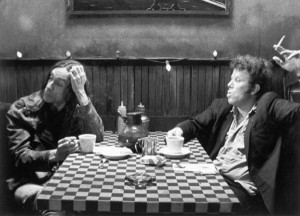 Slate reports on the success of Cups, an app that allows people unlimited (sort of) cups of coffee from independent cafes in New York:
Slate reports on the success of Cups, an app that allows people unlimited (sort of) cups of coffee from independent cafes in New York:
For $45 a month, you can use the app to order as much tea and basic hot coffee as you want at any of Cups’ 28-and-counting member locations; for $85 you can add lattes, iced coffee, and other espresso-based beverages into the mix. And as part of the soft-launch, everything is free if you download the app. Everything. Until early next week. …
The genius of Cups is the notion that the best aspects of big chains like Starbucks and of local cafes like Pushcart can be merged. “We see Cups as a new kind of coffee shop chain,” [Gilad] Rotem [a co-founder] says. “We’re uniting independent coffee shops together and giving them economics of scale and tools that they cannot get by themselves, but keeping their independent atmosphere. It’s a chain of independence.” …
In addition to its monthly unlimited plans, Cups also offers X-cups-for-$Y deals aimed at less severely coffee-dependent users. Most coffee shops use a coffee machine rental of their own to make their coffee. Coffee shops don’t pay a fee to join the program, and Cups reimburses them at a discounted rate when customers purchase drinks through its app. Greg May, an owner of the Uncommons in Greenwich Village, said Cups essentially pays the shop half of its retail price on each drink. “It’s certainly brought in a lot of new business,” he says. “I think it’s a compelling value proposition for the consumer.” While the Uncommons doesn’t register a loss on the discounted drinks, May says the hope is that customers who come in for cheap coffee will end up buying a pastry or sandwich too.
Speculative thoughts:
- Starbucks has an affinity deal, but not an all-you-can-drink model. Yet. I suspect that if Cups were to become greatly successful, and Starbucks began to feel a cut in its business, it might introduce a similar plan. For Cups’ business model to be strategic, it ought to anticipate the reaction of rivals.
- Something like an all-you-can-drink model makes some sense. A lesson from the economics of pricing quantities is that it is always a good idea to have a high-quantity option where the customer is paying marginal cost for the last units consumed. For example, if you were putting on a festival, in addition to tickets for individual shows, or packages of three or five shows, there always ought to be an option for all-you-can-attend (as the marginal cost of allowing patrons into additional performances is almost zero). Museums should always have a membership option that comes with unlimited free visits. The marginal cost of producing a cup of coffee isn’t zero, but it is very low (any experts out there? It must be less than 25 cents?). So it is almost surprising Starbucks has not yet gone this route. Although that is complicated by …
- Cafes sell multiple products: coffee, ‘enhanced’ coffees, foods and other drinks (sometimes strategically priced at very high mark-up – have you ever bought an orange juice at a Starbucks?), and, importantly, space, to relax, talk, read, catch up on homework. Space cannot be purchased a la carte, but can be enjoyed at zero additional price for those who have bought a drink or food. So, consider a patron at Starbucks (to stay with that example) who really wants to hang out and use the comfortable space and free wifi: that person needs to keep buying coffee, she cannot just hang out at Starbucks all day (I have never seen anyone actually asked to leave, but I think social norms are ingrained enough that we make our way to the door when we really don’t want to buy any more coffee). But with the Cups app, an individual most interested in buying ‘space’, once they have the app, pays no price at the margin (they get a free refill every half hour). So we would expect more lingering. This is not such a bad thing for the cafe’s owner, who gets reimbursed from the Cups company, at about half the retail price of a cup (still well above marginal cost of production).
- An interesting aspect of the Cups model is that it brings independent stores into a sort of coalition. What are the arts applications? Suppose, for example, an app, bought for price $X per year, that got you 20% off books bought at any out of a group of independent bookstores, where the firm running the app reimbursed the stores a portion of the discount on the books. A way to give a discount to frequent buyers without tying them to one particular store? Amazon Prime gives buyers unlimited fast-delivery on books, for an annual fee – this could be a way for independent stores to compete.
- Let me know of the best examples you have seen of from coalitions of arts organizations …

[…] That and an app will get you a cup of coffee AJBlog: For What it’s Worth | Published 2014-04-28 […]